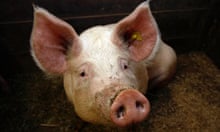Leaving the EU is likely to lead to an increase in the number of megafarms dominating the British countryside, campaigners and farmers agree, with far-reaching effects for farms, consumers and those who live in the countryside.
The huge intensive farms, in which as many as 1.7 million animals may be kept on a single holding, are an increasingly common, but controversial, feature of UK agriculture. The pressures of Brexit on farming are likely to cause more farmers to move to such facilities in order to lower the costs of meat production, and may squeeze smaller more traditional farms out of the market, potentially changing the UK’s landscape forever.
Chickens have become the focus of concerns over the effects of Brexit, with a row over whether the UK should import chlorinated chicken from the US, and chicken farming is likely to be the first to expand. Richard Griffiths, chief executive of the British Poultry Council, said: “The poultry meat industry is the only livestock sector that is capable of quickly scaling up production to meet growing demand and support increased self-sufficiency [post-Brexit]. Large-scale farming done to a high standard is a national asset. A secure post-Brexit deal must be about Britain’s future food security and safety.”
Megafarms, of a size previously rare in the UK but common in the US, are under attack from campaigners because of concerns over animal welfare, as livestock are kept in intensive conditions often without access to the outdoors. However, farming leaders argue they can deliver efficient food production without lowering standards. What both are agreed on is that they could change the nature of the countryside, as small traditional holdings are pushed out or swallowed up and the large sheds of industrial-scale farming are installed.
Tim Bonner, chief executive of the Countryside Alliance, said that the trend towards larger farms has advantages in efficiency and could deliver high-quality affordable food. But he added: “As the UK develops post-Brexit rural policy it is vital that we remember that in many parts of the country, farms are not just businesses. Entire cultural landscapes rely on traditional smaller farm units and future policy must conserve all the benefits they bring.”
Christopher Price of the Country Land and Business Association (CLA), which represents landowners and rural businesses, warned of the challenge to traditional farms, and urged intensive farmers to be sensitive to their surroundings. “The weak bargaining power of smaller farms is one of the biggest challenges the industry faces,” he said. “The real issues are the standards and ethos of the individual farmer: a good farmer will choose to meet high welfare and biosecurity standards, protect natural resources, make some space for nature [and] maintain an attractive landscape.”
Campaigners say that the nature of such megafarms mitigates against an attractive landscape. In the US, with its wide open spaces, it is easy to site megafarms away from dwellings. But in the densely populated UK, there is less space for such large developments and inevitably people will be affected. A joint investigation by the Guardian and the Bureau of Investigative Journalism has found 789 farms in the UK that would meet the US definition of a megafarm, and a rise of more than a quarter in the number of intensive farms, which are now widespread throughout the country. People living near such facilities have complained of overpowering smells, noise and heavy traffic on small rural roads, while researchers have found evidence of superbugs in the vicinity of intensive farms.
Tracy Worcester, director of Farms Not Factories, warned: “Local residents in our green and pleasant land will be poisoned by ammonia and sickened by antibiotic-resistant organisms and bioaerosols that come out of the sheds. Downwind of a mega pig farm, drying laundry is stained, you cannot eat or sit outside, flies multiply and the pervasive stink invades rooms even when the windows are closed. Tourism dries up, B&Bs and pubs close, local communities disperse.”
Claire Bass, UK executive director of Humane Society International (HSI), one of the world’s biggest animal protection charities, said British farmers would be more likely to intensify their farming to compete on price in post-Brexit trade deals. “A Brexit-fuelled acceleration in megafarms would be terrible news for people, the environment and, of course, animals. These intensive farms are also extremely harmful to the environment, causing serious damage through ammonia emissions and water pollution.”
She warned of a backlash: “HSI aims to prevent the spread of megafarms by making sure existing animal welfare laws are protected and enhanced as Britain leaves the EU.”
The debate around the effects of Brexit on British farming was intensified this week when the Brexit minister Liam Fox refused to rule out imports of meat from the US of a lower standard than the EU permits. The government had to move swiftly to reassure consumers that chicken treated with chlorine, as it frequently is in the US, would not appear on British tables, and promised that high standards of livestock welfare would be retained. In the US, for instance, animals on megafarms are often kept in cramped conditions, fed with growth-promoting hormones and routinely dosed with antibiotics. In the EU, intensive farms are closely regulated to ensure minimum standards of welfare that would rule out these US practices, though critics say these standards are still insufficient.
Despite government reassurances, the issue revealed the rifts within the cabinet over what is at stake in future trade deals, and presages more rows to come as the implications of Brexit become clearer.
Early concerns over the impact of Brexit on British farming centred on the issue of subsidies, worth roughly £3bn a year to farmers under the EU’s common agricultural policy. The government has committed to keeping these to 2022, but after that there is little indication of what will happen.
It is now clear that the impacts will be much wider, affecting the food we eat, the conditions in which animals are kept and fields are cropped, and the nature of the countryside.











Comments (…)
Sign in or create your Guardian account to join the discussion